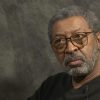The movement has certainly gained attention. But its decentralized structure means it runs the risk of going the way of Occupy Wall Street.
Ferguson is the raw, visceral, unsavory face of pure racial emotion and despair pouring into the streets. It is unpredictable, it can be frightening, but above all else it is essential. American society needs once again to see the frustration and anger that is born from racial injustice.
The original narrative of Michael Brown’s death—of a young black man who had just graduated high school being gunned down in the street by someone who has sworn to protect him, and whose body was allowed to rot in the scorching summer heat for four hours while his friends, family, and neighbors helplessly watched—was the moment when many African Americans decided to make their pent-up frustrations known to the rest of America. Many coalesced into passionate and activist-driven peaceful protests, and a select few unfortunately resorted to violence. This is when the Black Lives Matter movement caught fire.
A year later, the movement is most certainly at a crossroads. Sunday, the peaceful protests organized by Black Lives Matter activists on the anniversary of Brown’s death were marred by violence, shootings, and arrests. That night, a black male opened fire on police officers, and by Monday a state of emergency was declared. That same day, roughly 200 activists staged a sit-in at the U.S. attorney’s office in St. Louis and 57 were arrested. Those arrested included Cornel West and prominent social media Black Lives Matter personalities DeRay Mckesson and Johnetta Elzie.
Additionally, last Saturday, Black Lives Matter activists interrupted and eventually shut down a Sen. Bernie Sanders rally, similar to their actions at NetRoots Nation in July, demanding that he take bolder measures to confront police brutality and racial inequality.
So the movement is out there getting attention and generating press. But all of this noise needs to bring about a sustained change. A movement has to be more than merely raw emotion, and catharsis, and this is an evolution that Black Lives Matter needs to undertake.
A prime example of the movement’s organizational confusion is found in the strange interactions between Sanders and “members” of the movement over the past month or so. At the Sanders rally, it was Marissa Jenae Johnson and Mara Jacqueline who stormed the stage to confront the Senator. But Johnson’s and Jacqueline’s connection to the movement appears tenuous at best. But Black Lives Matter does not have a central leadership or organizational body, so almost anyone’s official connection with Black Lives Matter can come into question.
“Black Lives Matter is a movement, but it is also a mantra,” said Jonathan Newton, the founder and president of the National Association Against Police Brutality. “It does not have a centralized structure, and that is what I think causes some confusion and also allows this movement to live on.”
But one might wonder: Why is Sanders still being targeted more than other presidential nominees when his long record of civil rights advocacy is at least now known to most? Maybe a month ago at NetRoots his positions on police brutality, inequality, and race were unknown, but they should not be now.
And why isn’t Hillary Clinton receiving an equal barrage of interruptions and demands from members of the Black Lives Matter movement? You could argue that her recent speech on criminal justice reform has shielded her from these attacks, but no one can really know for sure.
And more than that, why isn’t the GOP being bombarded with interruptions? It makes you wonder about the wrongs Sanders must have committed, but confusingly, none of these questions has a clear answer, and they cannot because there is not a central leadership to this movement to provide them. Almost all parties could be defined as rogue factions united by a similar ideology and mantra.
Sanders has most likely received more abuse than others because his events are more accessible than other candidates’ due to the large crowds they draw. The combination of easy access and sizable media coverage has made him an easy target. But the movement clearly cannot sustain itself on these predatory actions alone. These interruptions need to evolve and have a more clearly defined purpose.
“We can question the method of what these interrupters have been doing, but we cannot question the message,” said Newton. “And that method has already produced responses.” In the last week, Sanders has appointed Symone Sanders, an African American woman, as his national press chair, and he has published a detailed outline of his stances on racial injustice on his official website, so the potential impact of these interruptions is clear.
Charting their future course is not. When will other presidential candidates get ambushed? How does the movement remain vibrant enough to ensure that the proposed changes become a reality?
On the flip side, the nearly nonexistent organizational structure has allowed numerous independent “Black Lives Matter” groups such as Newton’s NAAPB to arise and work for positive change on the racial injustice issues that the movement espouses, and this has energized and activated countless individuals who previously were passive observers.
If Black Lives Matter is to have the impact its activists demand through sit-ins, confrontational interactions with presidential candidates, peaceful protests, and sometimes volatile demonstrations, then the group needs to unite and organize to a more substantial degree than it does now.
The civil rights movement of the 1960s had many different groups, including the NAACP, the Southern Christian Leadership Conference, the Student Nonviolent Coordinating Committee, and more. These groups independently organized supporters and occasionally clashed, while promoting the same message of change.
Black Lives Matter could peter out similar to the Occupy Wall Street movement. Maybe it will organize its activists like the Tea Party has and have a noticeable impact on our government. Could Black Lives Matter Democrats become a significant force in the not too distant future?
The issues that Black Lives Matter wants to impact will not be solved overnight or in one election cycle. A sustained level of advocacy, organizing, and peaceful protesting needs to occur for a long period of time, and this cannot be achieved without BLM evolving into a more organized and focused movement.














